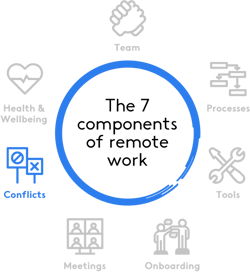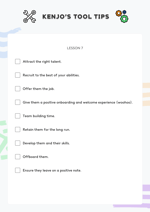Lesson 7: How to manage conflict in remote teams

Managing conflict is an everyday concern in any professional environment, but especially important in remote work as misunderstandings are more likely to happen without in-person verbal and non-verbal communication. For the purpose of today’s lesson, we will address the main components in managing conflict and risk: communication, goal-setting and planning.
Key Learnings
✓ Communication.
✓ Perception management.
✓ Constructive feedback.

Risks and conflicts while working remotely
Think about a time in your career when you said and meant X, yet, it was somehow heard and implemented as Y. Or, recall a moment when you could have sworn that a person said A, and then it turned out that they actually meant to say B.
Miscommunication in the workplace happens daily, and while it’s mostly unintentional, it usually comes with a high price to pay. According to David Grossman, who surveyed 400 large-scale companies in the US, companies lose (on average) more than sixty-two million dollars per year due to “inadequate communication between employees.”
And, according to the Marlin Company, employees forego forty minutes of productivity per day due to confusing instructions by managers. Which is pretty crazy if we do the math - almost one month of productive work time lost (per year) due to miscommunication.
With that said, it’s clear to see that miscommunication sets the tone for a great deal of risk and conflict at work - not to mention employee turnover. As mentioned in HBR, companies who have 👍🏻 effective communication scores are fifty per cent more likely to have better turnover rates than the industry average. In other words, if you communicate effectively, you’re more likely to retain your high performers!
Does this sound familiar to you? 🙂 Managing a team in the office is one thing, but being out of the office in an entirely different location represents a whole new level of potential issues.
In today’s lesson, we will walk you through the most common risks and conflicts that arise while working remotely, as well as provide you with the best ways to overcome them. It’s better that you spend your sixty-two million dollars elsewhere.
The four factors that will reduce conflict in remote work collaboration:
1. Teammates believe everyone is pulling their weight.
2. Open, honest and consistent communication.
3. Aligned goals, priorities, and expectations on projects.
4. Everyone knows their place on the team.
Let’s first talk all about: COMMUNICATION

Always remember: 🔑 Communication is key
ONE: Know your formats and when to use them
In digital communication, there are various formats you can use to communicate and collaborate with your teammates. However, if you’re not intentional about what type of communication happens where and when, it’s easy to fall into the trap of miscommunication. Here are some examples that you can use to create your remote work communication policy:
- Email:
If you need to send a long message that needs to be read a few times or needs to be permanently recorded, we suggest using email. It’s better to use email for recording communication, such as a company-wide strategy announcement.
- Chat:
If communication is intended to be no longer than a single line, informal, funny/silly or interactive, then we suggest using a chat tool.
- Phone:
If communication needs to go back and forth many times before arriving at a consensus, we suggest jumping on a call to get on the same page. It’s more efficient, effective and less likely that someone will get annoyed at being CC’d when they don’t want or don’t need to be.
- Facetime:
If you have sensitive information to disclose or you need to discuss ways of working, a video call is best. Video allows you to show verbal and non-verbal communication such as smiling, nodding, hand gestures that could be helpful to get your point across in a more empathetic way.
TWO: Careful language
Regardless of what communication format you are using, if you are collaborating remotely, you need to be extra careful. Be cautious of tone and language via phone/facetime, always add more context than you think is necessary via text. Always make sure you use empathy in your emails and check before sending it and don’t be afraid to use some emoji’s 😎
THREE: Spend time getting on the same page
It’s always best to go through the details of a project in-depth to make sure everyone is aware and understands the direction and ultimate goal of the project..
The following statements are useful:
- “This is what you said, this is what I understood, is that what you meant?”
- “I understand that you want X, by X date, because of X reason. Is that accurate?”
- “I am going to do THIS, you will do THIS, and in the end, we will accomplish THIS.”
Our preferred tools:
- Chat tools: Slack, Google Hangouts
- Facetime tools: WhatsApp, Zoom, Google Meet
- Collaboration tools: Miro, Evernote, Google Doc, Invision
- Timetable tools: Timebuddy, Calendly, WhenIsGood
- Project management tools: Asana, Trello, Jira
- Screen recording tools: Camtasia
Next up on the miscommunication list: GOAL SETTING
 Remember:
Remember:
🔑 Set goals as a team
🔑 Practice positive reinforcement
🔑 Give quality feedback
To achieve anything impactful, you must have a clear vision of where you’re going and an aligned team who have identified their SMART goals and are working hard to make them a reality.
This is a very important step in managing risk and conflict, because if everyone knows each other's expectations,serious disputes are much less likely to arise. You can do this successfully by focusing on the following three elements:
ONE - Set your objectives as a team
We have written about this topic in-depth - you can find it here:
- Guide to performance appraisals for Human Resources
- How to foster a higher employee engagement score
TWO - Positively reinforce behaviours
If your teammates are displaying exemplary behaviour, call it out! People will then understand the behaviours required to do a good job, in your eyes. You’ll alsobe more likely to be rewarded with this level of effort in the future. We believe in positive reinforcement so much, that we’ve designed a special feature in our tool for it called Kenjo Shoutouts.

Shout-outs work like a charm to boost confidence and motivation for both employees and employers. Kenjo’s Shoutouts feature is shared publicly across teams and channels.
The six golden rules for praise:
-
-
-
- Praise honestly.
- Be specific.
- Be comprehensible.
- Praise promptly.
- Give emotionally tangible praise.
- Praise often.
-
-
THREE - Reflect on behaviour and provide feedback for improvement
If conflicts do arise during a project or a period of time, be sure to set aside time to discuss it when the project has finished. It’s important to do this to ensure certain behaviours don’t continue in the future. It also shows that you are not a boss who punishes behaviour, but instead coaches and redirects it for a better outcome.
Making sure your employees feel that it’s okay to make mistakes (if they can fix it after feedback is given) is a great way for maintaining an innovative culture and dealing with conflict. On that note, we have a few more tips:
- Develop a clear policy on giving and receiving feedback.
- Don’t normalise other people's actions and choose to stay quiet to keep the peace. The other person will continue to do what you find frustrating and the conflict will only grow.
- Hold off on non-essential or urgent communication until you are in a better mood.
- Run a training session for assuming positive and innocent intent.
- Rather than jumping to conclusions about a person's statement, ask open-ended questions to understand what they actually mean. As Lisette Sutherland says:

Last but not least, manage your routines and plans
🔑 Be prepared for nine key plans.
Have a think through the necessary systems, routines and plans you will need to put in place to ensure your employees have a great start, middle and ending (when the time comes) at your company.
By doing this, you will avoid a lot of misunderstandings, have a better chance at scoring high on your Enps and avoid unnecessary risks and conflict. Here’s the ultimate checklist to add to your conflict reducing and risk management plans:
➡️➡️ Print out your Kenjo connection checklist here to tick off what's most important: Download checklist. ⬅️⬅️
That’s it! You’re all done with the lesson on managing risk and conflict while working remotely. So what do you think? Do you feel you’re able to reduce your potential for conflict, lower the ridiculous costs associated with miscommunication and offer some useful tips for these issues?

![]() Be honest and err on the side of over-communication.
Be honest and err on the side of over-communication.
![]() Set clear expectations and goals and give reasons for the urgency or pressing need for performance to bring everyone on the same page.
Set clear expectations and goals and give reasons for the urgency or pressing need for performance to bring everyone on the same page.
![]() Stick to a consistent check-in routine.
Stick to a consistent check-in routine.
![]() Practice your empathy and “put yourself in other people’s shoes.”
Practice your empathy and “put yourself in other people’s shoes.”
![]() Trust your coworkers - trusting in teamwork makes the dream work.
Trust your coworkers - trusting in teamwork makes the dream work.
![]() Try to create WIN- WIN situations.
Try to create WIN- WIN situations.
![]() Make sure you communicate through the correct format, at the right time.
Make sure you communicate through the correct format, at the right time.
![]() Put policies in place for communication, set up training to create better communicators in your organisation and set your people up for success!
Put policies in place for communication, set up training to create better communicators in your organisation and set your people up for success!
![]() Schedule designated work times, if that’s part of your company culture
Schedule designated work times, if that’s part of your company culture
What’s up next?
Next up is the last and final lesson - wow, time really flies doesn't it?
Lesson 8 is all about how to best establish a work-life balance for yourself and for your coworkers while working remotely. It is loaded with best practices and awesome formats that you definitely won’t want to miss out on 😍.
We’re glad you’ve enjoyed the lessons so far and we can’t wait to hear what you think about tomorrow's lesson.

